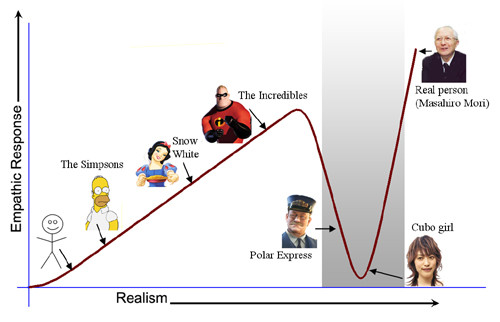These photos show an example of a virtual human “coach” with two levels of realism. Do you find one more unsettling than the other? A search of “uncanny valley” on the Internet reveals some very creepy examples of the uncanny-valley phenomena.
The use of artificially intelligent virtual-human systems are on the rise, as they can provide a highly efficient and effective way for people to access care services. While how unsettling the appearance of a virtual human may be is in the eye of the beholder, the goal of designers of these systems is to find the appropriate balance between level of realism and what is acceptable by end users who are to interact with them. The appropriate balance for use in mental health care contexts is a question that requires further research that combines psychology, art, and software engineering in a very exciting way.By David D. Luxton Ph.D.
Research Psychologist & Program Manager
The National Center for Telehealth & Technology (T2)
 |
| The Holographic Doctor |
Besides appearing weekly from January 1995 - September 2001 on Voyager, the Holographic Doctor also delighted fans by popping up in Star Trek: First Contact and, along with his even crankier creator, in the Star Trek: Deep Space Nine episode "Dr. Bashir, I Presume" (picture of Dr. Lewis Zimmerman and Dr. Julian Bashir, picture of Zimmerman and Leeta). Will we see the Doctor (now christened with the name - or part of a name - of Joe), Doctor Zimmerman, or some version of the Emergency Medical Hologram ever again? That's unknown at present, but this webmaster can hope!
Video: Star Trek-style holodeck becomes reality as scientists invent 3D vitual reality system - Telegraph
Virtual reality helps veterans with PTSD - Health & wellness - The Boston Globe
Increasingly, therapists are using virtual reality systems in conjunction with a form of talk therapy to treat veterans with symptoms of post-traumatic stress disorder, tailoring the scenes to patients’ memories to help them relive and process difficult emotions.As many as one in five people who served in Afghanistan or Iraq suffer from symptoms of PTSD, though estimates are higher for certain groups of veterans. Few seek treatment.


No comments:
Post a Comment